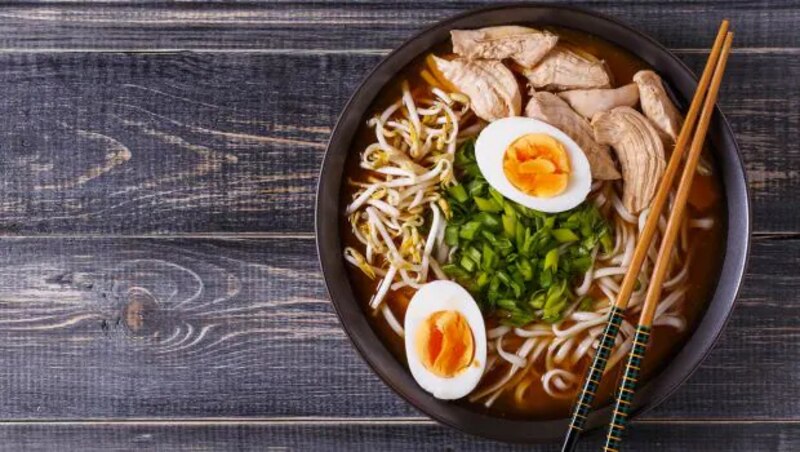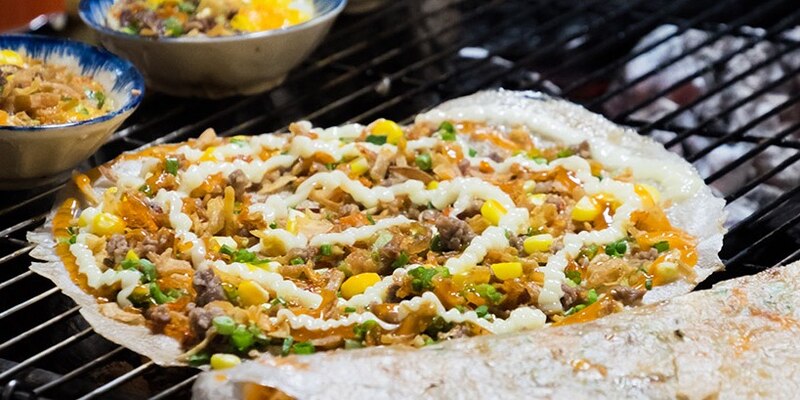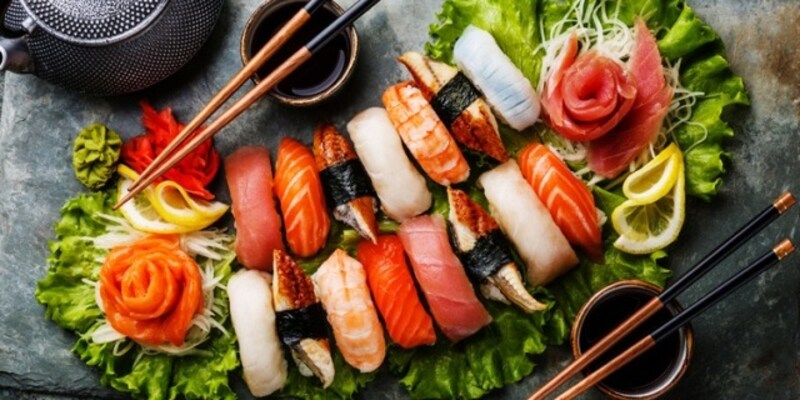Cuisine from Japan is famous worldwide because it focuses on being fresh, simple, and matching the time of year. Having its origins in a strong cultural past, this food style provides a wide variety in taste and texture. The range of dishes is vast, ranging from sushi to ramen, and displays both local specialties as well as popular favorites across the nation. This list shows essential Japanese foods and traditional dishes, which represent the heart of Japan's food culture. Get ready to explore a collection of classic and popular choices in Japanese cuisine.
The Art of Sushi
Sushi, one could say, is the most well-known Japanese dish that represents their food culture. Coming from a tradition of keeping fish in fermented rice, sushi has grown to be enjoyed globally. Usual sushi is made with rice mixed in vinegar and combined with many kinds of toppings such as raw fish or sometimes seafood along with vegetables. The main kinds of sushi are nigiri, sashimi, and maki. Nigiri is a piece of hand-formed rice with fish on top; sashimi means sliced raw fish; and make refers to rolled sc sushi. Every kind has its distinct taste of ingredients that show their freshness and quality.
Preparing sushi is a very detailed task, with chefs carefully balancing rice and toppings. In sushi restaurants, they pay special attention to the fish's quality and cooking methods The skill of forming rice into a shape is also highlighted, along with using ingredients that are in season for better taste and freshness.
- Freshness: Sushi is best enjoyed at its freshest, so try to visit reputable sushi bars where ingredients are sourced daily.
- Regional Variations: Different regions in Japan offer unique variations of sushi, such as the Edo-style sushi in Tokyo or the Osaka-style pressed sushi.
Exploring Ramen Varieties

Ramen, a main part of Japanese cooking, is made up of Chinese-style wheat noodles in a tasty broth. There are different types of ramen from each region and they can be recognized by their broth style, seasoning, and toppings. Shoyu ramen has a soup base that relies on soy sauce while miso ramen uses strong miso paste for its flavoring. Tonkotsu ramen, with its thick, pork-based broth and shio ramen that uses a salt-based seasoning. Ramen can be garnished with various ingredients like sliced pork, bamboo shoots, or green onions which give each bowl its own unique taste experience.
Ramen is liked by many because it can be adjusted to personal preferences and has diverse regional characteristics. You can put different toppings on each bowl and change the broth base, showing local flavors and items. Apart from regular kinds of ramen, there are also unique versions in certain restaurants such as those with spicy or seafood broths.
- Customization: Many ramen shops allow you to customize your bowl with additional toppings or changes to the broth.
- Regional Differences: While Tokyo and Hakata have distinct ramen styles, other areas like Sapporo offer unique flavors influenced by local ingredients.
Understanding Tempura
Tempura, a dish from Japan, is made by gently coating seafood or vegetables in batter and then frying them deeply. The way of cooking tempura makes the taste of ingredients more prominent while also giving a light and crunchy texture. You make the batter for tempura using a combination of flour with water and sometimes a simple egg Tempura is about getting the right mix of light batter and ingredients that are cooked just enough. People often eat it with a sauce for dipping, which we call tentsuyu, along with some grated daikon radish on the side.
People often praise tempura for its crispy and light texture, which is different from the heavier fried foods we're used to. The method of quick frying at a high heat guarantees that the batter stays light and does not soak up excessive oil, preserving the original taste and texture of the ingredients.
- Serving Temperature: Tempura should be eaten immediately after cooking to maintain its crispy texture.
- Variety of Ingredients: While seafood is common, vegetables like sweet potatoes and mushrooms are also popular in tempura dishes.
Savoring Takoyaki
Takoyaki, a tasty street food from Osaka, is prepared by mixing a batter with minced or cut-up octopus, tempura bits, and pickled ginger. This mixture is then poured into special molds and cooked until it turns golden brown. Common toppings for takoyaki are takoyaki sauce, bonito flakes, and chopped green onions. It creates an enjoyable mix of different textures and tastes that people love to have as a snack in this place, whether they are from here or tourists.
The process of making takoyaki has its technique to get the desired texture and taste. Takoyaki grills have round molds to make sure they have their typical ball shape. Every ball is cooked so that it becomes crispy on the outside but still soft and gooey inside.
- Cooking Equipment: Special takoyaki grills with spherical molds are used to ensure the correct shape and cooking consistency.
- Popular Toppings: The traditional toppings include takoyaki sauce, bonito flakes, and aonori (seaweed flakes).
Delving into Okonomiyaki

Okonomiyaki, it's a pancake from Japan that is made by mixing flour, eggs, and shredded cabbage along with different things like meat or seafood plus cheese if you want to add some. The word "okonomiyaki" means "grilled as you like it" when we translate it into English, showing how flexible this dish can be. After making the batter all nice and mixed up together. They cook that on a hot flat cooking surface called a griddle then usually put sauce over top before serving along with mayonnaise sometimes as well as bonito flakes often seen sprinkled on top too. Both Hiroshima and Osaka are known for their love of Okonomiyaki, with each city having its unique take on this dish.
The making of okonomiyaki is a process that provides room for creativity and individual choices. Many times, people will put their touch on the pancake by adding different things inside it as per their liking. In the Hiroshima-style okonomiyaki, we don't mix these ingredients but instead layer them one by one. This gives it an interesting texture and taste combination.
- Regional Variations: Hiroshima-style okonomiyaki includes layers of ingredients, while Osaka-style mixes all components.
- Customizable Ingredients: You can add various ingredients like squid, shrimp, or cheese to suit your taste preferences.
Experiencing Kaiseki Cuisine
Kaiseki, a classic Japanese dinner with many courses, shows the beliefs of Japan in seasonality and balance. This fine experience of eating gives you a sequence of small dishes that are prepared carefully to reflect what is in season. Every dish is made pretty, good-tasting, and varied in texture for an overall pleasing dining moment. Kaiseki meals usually begin with an appetizer, then they serve sashimi, a cooked dish that comes next followed by soup and dessert. The way dishes are presented illustrates the artistic skill and philosophy behind the Japanese cooking tradition.
Kaiseki meals are about honoring Japanese culture, focusing on the value of seasonal ingredients and the importance of presentation. The meal moves forward in a sequence of courses that display various cooking methods and tastes, making sure to present a complete dining experience. Kaiseki is frequently savored during unique events, displaying the talent and artistry of Japanese cooks.
- Seasonal Ingredients: Kaiseki menus change with the seasons to showcase the freshest ingredients available.
- Artful Presentation: Each dish in a kaiseki meal is carefully arranged to highlight both flavor and visual appeal.
Conclusion
Investigating Japanese cuisine is like going into a universe of taste that comes from the country's cultural history and cooking creativity. From kaiseki's delicate craft to ramen's comforting simplicity, every plate tells a tale about tradition and flavor. As you start this food trip, you will understand why Japanese cuisine is still very interesting for people who love food worldwide.










